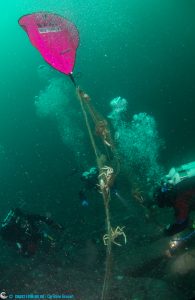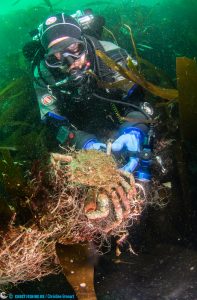Team work makes the dream work. Video: Christine Grosart
Ding! Ding! Ding! Notifications come in quick succession on Fred Nunn‘s mobile phone from the ghost net reporting system. Fred is volunteer operations officer at Ghost Fishing UK and on duty coordinating recoveries on the south coast of England. A large monofilament net has been spotted by several groups of recreational divers on the Hand Deeps reef eight nautical miles out to sea in the English Channel.
Fred swings into action. Chartering the dive vessel Seeker operated by In Deep Diving and Marine Services he puts out a call to Ghost Fishing UK’s network of trained divers. Soon he has ten volunteers from the Midlands, Greater London and the South West ready to respond.
Locating a monofilament net on a reef can be difficult. These nets are nearly invisible. Made from transparent nylon they hang in the water forming a curtain that traps unsuspecting fish and crustaceans. If snagged on a shipwreck they pose a hazard to divers but at least are easy to find. On a reef the area to search is much larger and breathing gas supplies are always limited.
British reefs are not formed from hard corals and teeming with small brightly coloured fish like the ones in the Red Sea or Caribbean. In our temperate waters reefs are rocky shelves or pinnacles, often covered in the summer by a dense forest of kelp seaweed and studded with soft corals like the ominously named ‘deadmens’ fingers’. They are important habitats nonetheless and support many hundreds of species. Divers and fishermen alike are attracted by the wide variety of animals that make their homes here.
“Hand Deeps is one of the most biodiverse reefs that we regularly dive and as such is a very popular spot with our customers. Their [ghost nets] swift and effective removal significantly decreases the impact to the marine environment and industries that depend on the health of our coast,” said James Balouza, skipper of dive boat Seeker.
It is early on a very sunny Tuesday in Plymouth. The air is oppressively humid and as we change into our drysuits there is a sudden flash of lightning and a clap of thunder that sends us ducking for cover from a summer storm. As quickly as it starts the rain stops. We finish preparing our equipment and skipper James casts off, motoring through the Sound out past the breakwater and onto Hand Deeps.
We have been briefed by today’s dive manager Christine Grosart. Our first task is to locate and survey the net. The reports have been helpful, giving a GPS mark and a description. On James’s call deckhand AJ drops a grapple over the side of the boat. Rope attached to it pays out to a buoy that will provide us with a visual reference while descending twenty-five metres to the top of the reef. The net has been reported to extend over the top of one of the five pinnacles that gives Hand Deeps its name. The net is long enough to extend over the side and we are concerned at how deep it may go. The surrounding seabed is at fifty-five metres but if it is deeper than thirty-four metres we will need a special breathing gas containing helium and will have to return another day.
It is still very hot on the surface as we wait to drop into the water. Our undersuits keep us warm for hours in the water but in the baking sun are less than comfortable. I’m diving with Jamie Vaughan and Tom Ball. Christine will join us with her camera.
We jump from the back of the boat and signal to go down. The water is cool and clear, a welcome respite from the sun. We descend and begin our search heading west from our entry point and then south keeping to a depth of twenty-five metres along the side of the reef. There are two other teams of divers in the water who have planned to take different directions and depths.
In only eight minutes I see the net suspended in a gully. Tom has seen it too. I signal for him to hold position while Christine readies her camera. He then inflates a surface marker buoy and attaches it to the net so we can quickly find it again on the second dive. I signal to the team to head east following the net into shallower water. Jamie has his wetnotes out to record the life that is hopelessly tangled in the net. Dozens of spiny spider crabs and a few brown crabs and lobsters. Tom assesses each one and Jamie makes notes. We hit our maximum dive time. We need to be quick so the second dive can also be in still water before the tide turns. As Christine takes a final photograph, I inflate my surface marker buoy to alert James and any other passing boats to our location. Then the four of us ascend together as I wind the string back onto the spool.
 |  |
The ghost net underwater. Image: Christine Grosart | Diver recording a spider crab. Image: Christine Grosart |
We are last back onboard Seeker and the other teams have also located the net. We plan its recovery. Fred’s team found the net at the same point we did, but then headed west into deeper water. His plan is to return there and attach lifting bags to the net starting at the west end. My team will head east and swim quickly to the other end and do the same. Paul Griffin‘s team will handle the middle. Our plan is ambitious. To lift the net in one piece using three teams of divers working in concert. We will try to unzip it from the reef using a series of lifting bags filled with air on the seabed.
We change our breathing gas cylinders and prepare for the second dive. Dropping down into the water we reach the net and swim along it, past our final location from the previous dive and on to the end. Fortunately it does not go much deeper. Jamie passes Tom a lifting bag and he hooks it through the net. I am acting as the safety diver, watching the net, the divers and out time and gas reserves carefully. Jamie adds some air to the bag from a separate cylinder – we don’t use our breathing gas for this – and sends the bag to the surface while Christine takes photographs. The net lifts up off the reef. We are good to carry on. We swim forward unsnagging the net from the reef as we go and attaching a succession of lifting bags back towards the west. Eventually we see Paul’s team signalling with their torches from the top of a small drop off and we pause. One final lifting bag before we ascend and get back on the boat.
Fred’s team has been successful too. Two hundred metres of monofilmant net is on the surface in less than half an hour. Now the laborious work begins – cutting 115 crabs, fish and lobsters free of the net takes hours before we can head back to port. Over eighty percent are still alive and are carefully returned to the sea. We don’t know whether they will survive their ordeal but at least they have a chance. The net will be stored prior to recycling. A successful day’s work.
Take a look at this Flickr album for more photographs.
Divers: Tom Ball, Paul Griffin, Christine Grosart, Martin Maple, Scott Morgan, Fred Nunn, Kerry Place, Andy Rath, and Dan Rawbone, Jamie Vaughan
In Deep team: James and AJ
Net reports are invaluable to our work. We are immensely grateful to Christine Ingram of Plymouth Sound Divers for reporting this net, and to Kieran Hatton and James Balouza for providing additional details.
| Diver profile: Dr Martin Maple | |
I started diving in 2013 and am now a BSAC Open Water Instructor and GUE Tech 1 / Cave 1 diver. At work I am an engineer working for an oil and gas consultancy. I joined Ghost Fishing UK in Scapa Flow back in 2017 for their first training course. I have written for and edited the Ghost Fishing UK newsletter and blog for nearly two years, and am currently an instructor-intern learning to teach the Ghost Fishing UK course myself. I am primarily a UK wreck diver but love project diving most of all. I am co-project manager of Project Baseline Midland Pools, which is surveying flooded quarries and monitoring crayfish species in Leicestershire and Warwickshire, while diving with several other Project Baseline teams. |



Thank you ,Thank-you ,Thank you ,it is because of wonderful people like yourself that I am optimistic for the health of our Sea,s and the glorious wildlife that call them home ,Kind regards Marilyn Lewis.